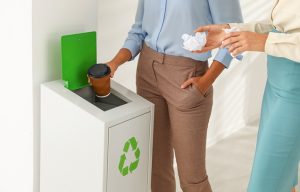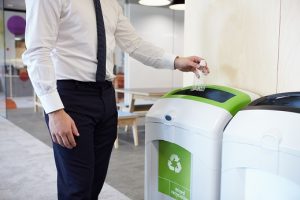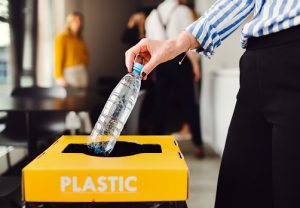
The digitization of office work, combined with the switch to remote work, pushed by the global pandemic, has no doubt influenced the amount of waste that businesses accumulate.
This, however, hasn’t resolved the issue of companies having to deal with the waste they produce. EPA- the United States Environmental Protection Agency estimates that on average, an office worker generates approximately 2 pounds of paper and paperboard waste a day. Moreover, half of all printed documents are thrown away within 24 hours.
And that’s not all, paper and paperboards are just one of the waste types people in offices accumulate.
So to understand where and how you can cut the waste your company produces, let’s take a more detailed look at the type of waste your office might be amassing.

Let’s begin by saying cutting waste in any area of our lives, including the office, helps us keep our environment clean, our resources intact for years to come, and garbage out of the dumpster sites.
As businesses have a greater impact on society they have the added responsibility of being a good example when it comes to waste management. Plus, reducing the waste in offices helps companies cut costs, and can become the social issue brands stand behind.
So here are the types of waste a company has to consider when trying to reduce their waste.
This category gathers all the miscellaneous paper waste like discarded mail, paperboards, boxes, delivery packages, magazines, catalogs, and all other paper waste that doesn’t fall into an individual category. Mixed paper waste totals about 70% of the entire waste generated in an office.
Every year, in the United States, roughly 108 billion pounds of food is thrown away. That’s 130 billion meals and over $408 billion in food waste. Food waste is the second-largest waste category that occupies national landfill space.
Among plastic packaging, plastic bottles, bags, and packaging, an office can accumulate overwhelming amounts of food. The average American uses 156 plastic bottles a year. Collectively we’re throwing away 2.5 million plastic bottles every hour.
While convenient, the majority of plastics are constructed from PET and HDPE plastics, and their recycling rates average at 29.1% and 29.3%, respectively.
The EPA estimates that on average a person creates 4.4 pounds of solid waste each day, including general waste materials like coffee cups, styrofoam plates, and thin, film-like plastics.
These are among the most commonly found in an office and sadly cannot be recycled.
E-waste is the fastest-growing domestic waste stream in the U.S.
The average person generated about 46 pounds of e-waste in 2019, which totaled at
6.92 million tons of e-waste in just one year. Of these almost 7 million tons only 15% were recycled.
Offices are rife with electronic devices like computers, monitors, printers, and even company smartphones, all adding up to the list of outdated, broken, and obsolete equipment that needs to be replaced at some point.
The proper disposal of outdated or broken electronic devices is extremely important not only because they are harmful to the environment, but also contain vital and recyclable materials like copper, aluminum, and semiconductor chips. Simply throwing away these devices is equivalent to throwing away billions of dollars.
Now that we’ve covered the main waste categories in the office, let’s look at how you can address its proper disposal.
Here’s how your office can step into the future and cut its harmful effect on the environment.

Paper waste is the easiest to recycle. In fact, it can be reused 5 to 7 times before it degrades. And while that’s good news, recycling requires a lot of additional resources, so cutting the use of paper is the best way to save resources and costs in recycling services.
To cut the use of the paper you can start implementing new policies around urging people to cut the use of paper, print double-sided, or only make copies and prints when necessary.
Online collaboration tools like Google Docs will also help your efforts in cutting the use of paper or even going entirely paperless.

If, however, going entirely paperless is not an option for your business you can set recycling stations and encourage people to actively participate in recycling paper from the office.
A few introductory meetings, educational sessions, and small prices will help you spread the idea and stimulate employees to participate in your recycling efforts. Placing the recycling bins close to office stations will also help.

Changing to eco-friendly options for your office supplies will help you further your waste-decreasing goals.
For example, you can switch to refillable ink cartridges and change printer settings to eco-friendly or ink-saving options. You can choose pens, pencils, and other office supplies that are either biodegradable or refillable, so you can use them longer or completely recycle them once no longer in use.

We’ve mentioned that electronics make up a considerable amount of office waste. You can offset your impact on the environment by organizing the recycling process of electronics no longer in use. Set a space in your office where electronics can be stored while waiting for pick up.
Some manufacturers offer collecting services for electronics your business no longer needs. This eases the process of recycling, especially when given that multiple states have legal requirements on the proper disposal of electronic devices.
Another option is to organize the collection of your off-service electronics through a waste management company that would pick them up periodically.

Biodegradable cutlery options will help you reduce the use of all the harmful and wasteful styrofoam cups, plates, and flimsy plastic utensils, flooding offices around the country.
Purchase dishes that are either made of materials that are easy to recycle or invest in quality dishware, cutlery, and cups for your office, that will last you longer and create a more welcoming atmosphere.

As part of your plastic-free office policy, you can offer your employees a reusable bottle to use around the office. Choose durable materials, aluminum or glass water bottles, that can easily be re-used.
You can even take advantage of the opportunity to turn this small gift into a promotional item for your brand, by printing your company’s logo on the bottles.
Setting up a filtered water system in your office will add to your efforts in reducing the use of plastic water bottles in the office.
You have a wide range of options to choose from depending on your budget. You can install a filtered water tap or keep a large water filtering pitcher in shared spaces, so it’s easily available to employees.

Set up a composting plan to recycle food scraps accumulated in the office. Food that can be composted includes coffee grounds, food scraps, and fruit peels. Among the compostable items in the office are also vegetable trimmings, flowers, plants, and non-treated cardboard.
You can even create a company’s activities around learning how to compose and helping city vegetable gardens by donating the compost you manage to create.
Another way you cut additional non-recyclable packaging and delivery waste, is by buying in bulk. Coffee beans for starters are a great alternative to individually packed k-coffee cups. Add a coffee grinder and a coffee machine to complete your coffee station set and create a place where you and your employees can enjoy work breaks.
You can bulk purchase other items like sugar, creamers, snacks, and cleaning supplies. You can go even step further by replacing some of the office cleaning supplies with biodegradable and environmentally friendly ones.

Recycling is a complicated topic that requires a lot of time. If you don’t have the time and staff to direct into re-imagining how your business takes care of its waste, you can always partner with a waste management company. Such an organization will help you educate your employees, organize the recycling and waste management process and dispose of the garbage properly.
Going green is the future. Recycling is not only an individual responsibility, but an organizational one, that has to be addressed by people and companies together. Sustainable business practices include adapting waste reducing and recycling processes, so if you haven’t already considered the option, now is the time.
But reducing waste is not something that should be viewed as a burden. Yes, decreasing your office waste and implementing recycling practices takes time, but in the long run, they can save you financial costs. Most importantly, they can help you reduce your carbon footprint.
We hope these 10 examples will give you ideas on how you too can decrease waste in your office.